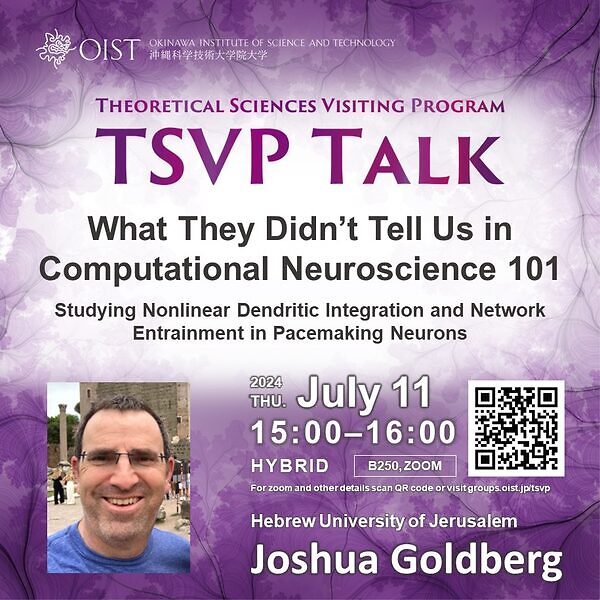TSVP Talk: "What They Didn’t Tell Us in Computational Neuroscience 101" by Joshua Goldberg

Date
Location
Description
Title: What They Didn’t Tell Us in Computational Neuroscience 101: Studying Nonlinear Dendritic Integration and Network Entrainment in Pacemaking Neurons
Profile: Dr. Joshua A. Goldberg is an associate professor of medical neurobiology at the Hebrew University of Jerusalem, Israel. His research focuses on the pathophysiology of movement disorders, most prominently Parkinson’s disease (PD). He combines advanced electrophysiology and imaging techniques both in vivo and in vitro with computational approaches to study how the physiology of neurons leads to their vulnerability in early statges of PD and how brain networks dynamics adapt to PD. He is a past recepient of a European Research Council (ERC) Consolidator grant and a Human Frontier Science Program (HFSP) grant with Dr. Jeff Wickens, OIST. Personal Website
Abstract: To simplify the description of neurons, neuroscience students are taught that neurons have a resting membrane potential (RMP), and require excitatory synaptic input to drive them to action potential threshold. Then, to simplify how neurons function in networks, neurons are treated as iso-potential (point-like) entities connected by synaptic weights. The first simplification is a prejudiced view that disregards diverse and ubiquitous classes of autonomously pacemaking neurons (that do not possess a stable RMP) in the brain. The second simplification disregards the complexity that dendrites add to the functions and calculations carried out by neurons. In my talk, I will describe my research that is aimed at making the contribution of dendrites to the response properties of pacemakers amenable to experimental investigation with currently available electrophysiological and optogenetic techniques. I will begin by introducing how the phase reduction formalism, provides a general framework for studying pacemakers, and present a recent study on how the framework explains spike correlations that appear in parkinsonism. I will then present how we used this formalism to study the role of dendrites in pacemaking neurons in the basal ganglia. We show that dendrites have a direct impact on how neurons encode their inputs and are entrained by them, and that we can use our formalism to probe the dendritic distribution of membrane non-linearities.
References:
1. Goldberg JA, Deister CA and Wilson CJ. Response properties and synchronization of rhythmically firing dendritic neurons. Journal of Neurophysiology 97(1): 208-19 (2007).
2. Tiroshi L and Goldberg JA. Population dynamics and entrainment of basal ganglia pacemakers are shaped by their dendritic arbors. PLoS Computational Biology 15(2):e1006782 (2019). doi: 10.1371/journal.pcbi.1006782
3. Oz O, Matityahu L, Mizrahi-Kliger A, Kaplan A, Berkowitz N, Tiroshi L, Bergman H and Goldberg JA. Non-uniform distribution of dendritic nonlinearities differentially engages thalamostriatal and corticostriatal inputs onto cholinergic interneurons. eLife 11:e76039 (2022). doi: 10.7554/eLife.76039
4. Olivares E, Wilson CJ and Goldberg JA. Phase delays between globus pallidus neurons entrained by a common oscillatory drive arise from their intrinsic properties, not their coupling eNeuro 11(5) 1-18 (2024). doi: 10.1523/ENEURO.0187-24.2024
Language: English, no interpretation.
Target audience: General audience / everyone at OIST and beyond.
Freely accessible to all OIST members and guests without registration.
This talk will also be broadcast online via Zoom:
Join Zoom Meeting
Meeting ID: 927 2173 1123
Passcode: 831631
※ Please note that this event may be recorded and the videos uploaded. In addition, photos may be taken during the event. These are intended for publication online (the OIST website, social media, etc.)※
Attachments
Subscribe to the OIST Calendar: Right-click to download, then open in your calendar application.



